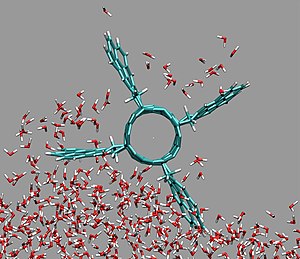Molecular propeller
A molecular propeller is a molecule that, due to its special shape, can propel liquids when it rotates, as it was constructed analogously to macroscopic propellers . It consists of molecule-sized wings arranged at a certain angle around a shaft, so that an axis of rotation is formed. The propeller, designed by Petr Král, University of Illinois at Chicago , consists of planar aromatic molecules as wings, while a carbon nanotube forms the shaft. Molecular dynamic simulations (see also molecular modeling ) show that these propellers can serve as efficient pumps, both in the depth and on the surface of the liquid. The effectiveness of the pumping depends on the interactions between the blades and the fluid. Propellers whose blades are hydrophobic due to their low polarity pump well. With hydrophilic wings, the water molecules form hydrogen bonds with the atoms of the polar wings. These can block the flow of water around the wings and slow down the pumping process.
function
Molecular propellers can be driven by molecular motors either chemically or biologically, with light or electrically, or with ratchet-like mechanisms. Molecular motors such as myosin , kinesin and ATP synthase are realized in nature . For example, rotary molecular motors attached to the protein-based ends (flagella or flagella ) of bacteria can move them forward.
application
Similarly, the overall structure of a molecular propeller and a molecular motor can form a molecular machine that can pump liquids. Further applications of these nanosystems range from analytical tools for chemistry and physics, e.g. B. in drug synthesis and gene therapy , and nanotechnologies (laboratory on a chip) to tiny nanorobots that are used to carry out various activities in the nano range.
Individual evidence
- ↑ J. Vacek and J. Michl, A molecular "Tinkertoy" construction kit: Computer simulation of molecular propellers , New J. Chem. 21 , 1259 1997 .
- ↑ CD Simpson, G. Mattersteig, K. Martin, L. Gherghel, RE Bauer, HJ Rader and K. Mullen, Nanosized molecular propellers by cyclodehydrogenation of polyphenylene dendrimers , J. Am. Chem. Soc. 126 , 3139 2004 . doi : 10.1021 / ja036732j
- ^ B. Wang and P. Král, Chemically Tunable Nanoscale Propellers of Liquids , Phys. Rev. Let. 98 , 266102 2007 . doi : 10.1103 / PhysRevLett.98.266102
- ^ TR Kelly, H. De Silva and RA Silva, Unidirectional rotary motion in a molecular system , Nature 401 , 150 1999 . Abstract
- ↑ N. Koumura, RWJ Zijlstra, RA van Delden, N. Harada and BL Feringa, Light-driven monodirectional molecular rotor , Nature 401 , 152 1999 . Abstract
- ↑ C. Bustamante, YR Chemla, NR Forde and D. Izhaky, Mechanical processes in biology , Annual Review of Biochemistry, 73 , 705 2004 . doi : 10.1146 / annurev.biochem.72.121801.161542
- ↑ RD Astumian, Thermodynamics and kinetics of a Brownian motor , Science 276 , 917 1997 . Abstract
- ↑ SP Tsunoda, R. Aggeler, M. Yoshida, and RA Capaldi, Rotation of the c subunit oligomer in fully functional F1Fo ATP synthase , Proc. Natl. Acad. Sci. USA, 98 , 898 2001 . Abstract
- ^ RK Soong, GD Bachand, HP Neves, AG Olkhovets, HG Craighead and CD Montemagno, Powering an inorganic nanodevice with a biomolecular motor , Science 290 , 1555 2000 . Abstract
